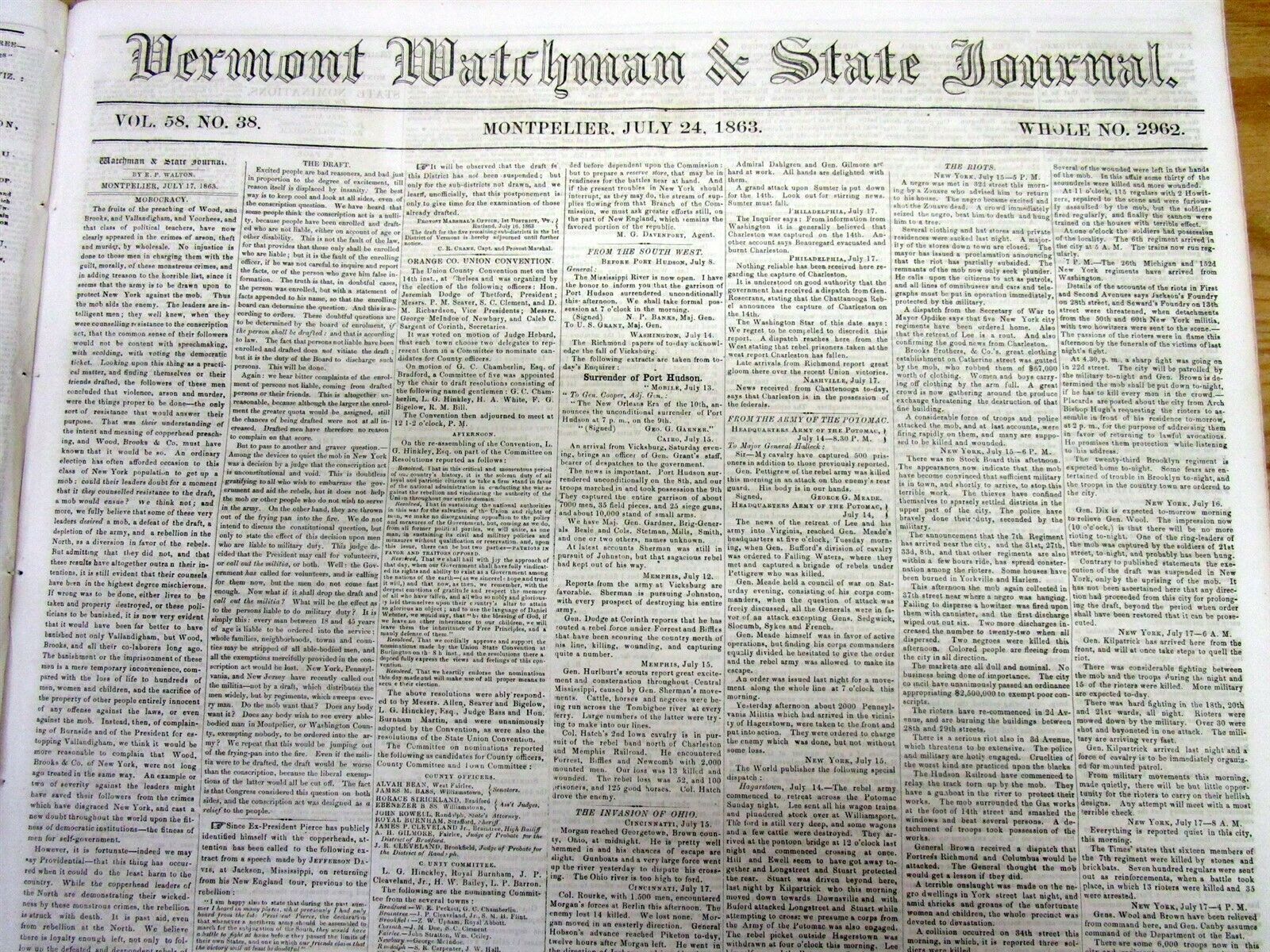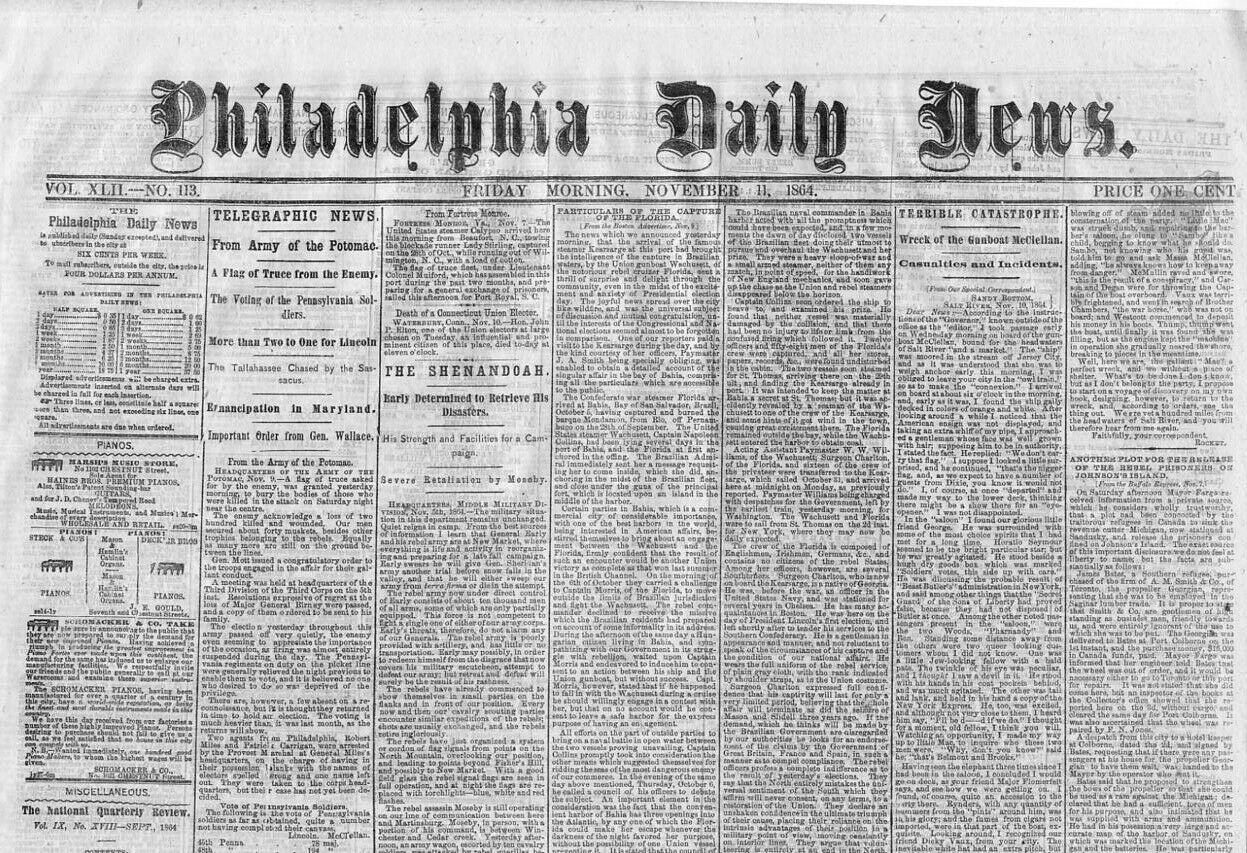-40%
1863 illus Civil War newspaper NEGR0 CHAPLAIN 1st Colored Regiment REV HM TURNER
$ 21.12
- Description
- Size Guide
Description
1863 illus Civil War newspaper NEGR0 CHAPLAIN 1st Colored Regiment REV HM TURNER1863 illustrated Civil War newspaper with portrait & biog of
REVEREND H M TURNER
, theNEGR0 CHAPLAIN of the 1st Colored Regiment
- inv # 7D-236
Please visit our
EBAY STORE
for THOUSANDS MORE HISTORICAL NEWSPAPERS for SALE or at auction
SEE PHOTO(s) - COMPLETE ORIGINAL illustrated Civil War NEWSPAPER,
Harper's Weekly
(NY, NY) dated Dec 12, 1863. This original illustrated Civil War newspaper contains a prominent 6" x 5" portrait and biography of the
REVEREND H M TURNER, the NEGR0 chaplain of the FIRST UNITED STATES COLORED REGIMENT
.
Henry McNeal Turner (February 1, 1834 – May 8, 1915) was an African-American minister, politician, and the 12th elected and consecrated bishop of the African Methodist Episcopal Church (AME). After the American Civil War, he was a pioneer in Georgia in planting new A.M.E. congregations among African Americans there. Born free in South Carolina, Turner learned to read and write and became a Methodist preacher. He joined the AME Church in St. Louis, Missouri, in 1858, where he became a minister. Founded by free blacks in Philadelphia, Pennsylvania in the early 19th century, the A.M.E. Church was the first independent black denomination in the United States. Later Turner had pastorates in Baltimore, Maryland, and Washington, DC.
In 1863 during the American Civil War, Turner was appointed as the first black chaplain in the United States Colored Troops. Afterward, he was appointed to the Freedmen's Bureau in Georgia. He settled in Macon and was elected to the state legislature in 1868 during the Reconstruction era. An A.M.E. missionary, he also planted many AME churches in Georgia after the war. In 1880 he was elected as the first Southern bishop of the AME Church, after a fierce battle within the denomination because of its Northern roots.
Angered by the Democrats' regaining power and instituting Jim Crow laws in the late nineteenth century South, Turner began to support black nationalism and emigration of blacks to the African continent. This movement had started before the Civil War under the American Colonization Society. Turner was the chief figure to do so in the late nineteenth century.
During the American Civil War, Turner organized one of the first regiments of black troops (Company B of the First United States Colored Troops), and was appointed as its chaplain. Turner urged both free-born blacks and "contrabands" (enslaved people who had escaped slavery and had their status classified as unreturnable because their former master's were engaged in war against the government of the United States) to enlist. Turner regularly preached to the men while they trained and reminded them that the "destiny of their race depended on their loyalty and courage". The regiment often marched to Turner's church to hear his patriotic speeches. In July 1863, the regiment had completed its formation and was preparing to leave for war. In November of that year, Turner received his commission as chaplain, becoming the only black officer in the 1st USCT.
Turner discovered that the duties of a Union army chaplain in the Civil War were not well defined. Before the war, chaplains taught school at army posts. During the war, the duties expanded to include holding worship services and prayer meetings, visiting the sick and wounded in hospitals, and burying the dead. Each chaplain had to work out his role in his regiment, based on the expectations of the men in his care and his own talents. For Turner, this appointment enabled him to grow in influence among African Americans.
Turner was a chaplain for two years. Shortly after reporting for duty, he caught smallpox and spent months in the hospital recovering. He returned to his company in May 1864, just before they participated in its first armed conflict, the Battle of Wilson's Wharf on the James River. From May through December, his unit participated in the fighting around Petersburg and Richmond, Virginia. At the end of the year, they fought in the massive amphibious attack against Fort Fisher.
Turner spent the spring of 1865 with his men as they joined Sherman's march through North Carolina. When the fighting ended, he was sent to Roanoke Island to help supervise a large settlement of freed slaves. Discharged in September, Turner was commissioned as chaplain of a different African-American regiment, which was assigned to the Freedmen's Bureau in Georgia. Shortly after arriving there, he resigned and left the army. He turned his attention to politics, civil rights, black nationalism, and evangelizing for the A.M.E. Church among Southern freedmen.
Turner became a politician during the Reconstruction era, being elected to state government; a powerful churchman, and a national race leader. While serving in the army, Turner refined his thinking about the African race and its future. He gained wider attention nationally by two activities related to the war. First, he wrote numerous letters from the battlefield to newspapers that were published, attracting many readers and admirers in the North. These were his base for a lifetime of journalism. Second, in the first months after the war ended, he used his position as army chaplain to attract emancipated freedmen into the A.M.E. Church. Most former slaves had formerly belonged to white dominated churches, and the expansion of the AME Church in the South strongly influenced African-American life. Turner was the first of the 14 black chaplains to be appointed during the war. Both the A.M.E. Church and the A.M.E. Zion Church, based in New York, also had numerous missionaries appealing to freedmen in the South.
After the war, Turner was appointed by President Andrew Johnson to work with the Freedmen's Bureau in Georgia during Reconstruction. White clergy from the North and former military officers also led some Freedmen's Bureau operations.
The newspaper usually contained 8 pages of text and 8 pages of gorgeous woodcut engravings, highly prized today for their detailed contemporary illustrations of events and places. The engravings are generally in 3 sizes: double page (DP - 21" X 16"), Full page (FP- 16" x 11") , and half page (HP- 10" x 8").
Very good condition. This listing includes the complete entire original illustrated newspaper, NOT just a clipping or a page of it. STEPHEN A. GOLDMAN HISTORICAL NEWSPAPERS stands behind all of the items that we sell with a no questions asked, money back guarantee. Every item we sell is an original newspaper printed on the date indicated at the beginning of its description. U.S. buyers pay priority mail postage which includes waterproof plastic and a heavy cardboard flat to protect the purchased item from damage in the mail. Upon request by the buyer, we can ship by USPS Media Mail to reduce postage cost; however, please be aware that USPS Media Mail can be very slow in its time of transit to the buyer. International postage is quoted when we are informed as to where the package is to be sent. We do combine postage (to reduce postage costs) for multiple purchases sent in the same package.
We list thousands of rare newspapers with dates from 1570 through 2004 on Ebay each week. This is truly SIX CENTURIES OF HISTORY that YOU CAN OWN!
Stephen A. Goldman Historical Newspapers has been in the business of buying and selling historical newspapers for over 50 years. Dr. Goldman is a consultant to the Freedom Forum Newseum and a member of the American Antiquarian Society. You can buy with confidence from us, knowing that we stand behind all of our historical items with a 100% money back guarantee. Let our 50+ years of experience work for YOU ! We have hundreds of thousands of historical newspapers (and their very early precursors) for sale.
Stephen A. Goldman Historical Newspapers
has been in the business of buying and selling historical newspapers for over 50 years. We are located in the charming Maryland Eastern Shore town of OXFORD, Maryland.
Dr. Goldman is a consultant to the Freedom Forum Newseum and a member of the American Antiquarian Society. You can buy with confidence from us, knowing that we stand behind all of our historical items with a 100% money back guarantee. Let our 50+ years of experience work for YOU ! We have hundreds of thousands of historical newspapers (and their very early precursors) for sale.
We invite customer requests for historical newspapers that are not yet located in our extensive Ebay listing of items. With an inventory of nearly a million historical newspapers (and their early precursors) we are likely have just the one
YOU
are searching for.
WE ARE ALSO ACTIVE BUYERS OF HISTORICAL NEWSPAPERS, including large and small personal collections, bound volumes, significant individual issues, or deaccessions from libraries and historical societies. IF YOU WANT TO SELL, WE WANT TO BUY !!!
Powered by SixBit's eCommerce Solution













